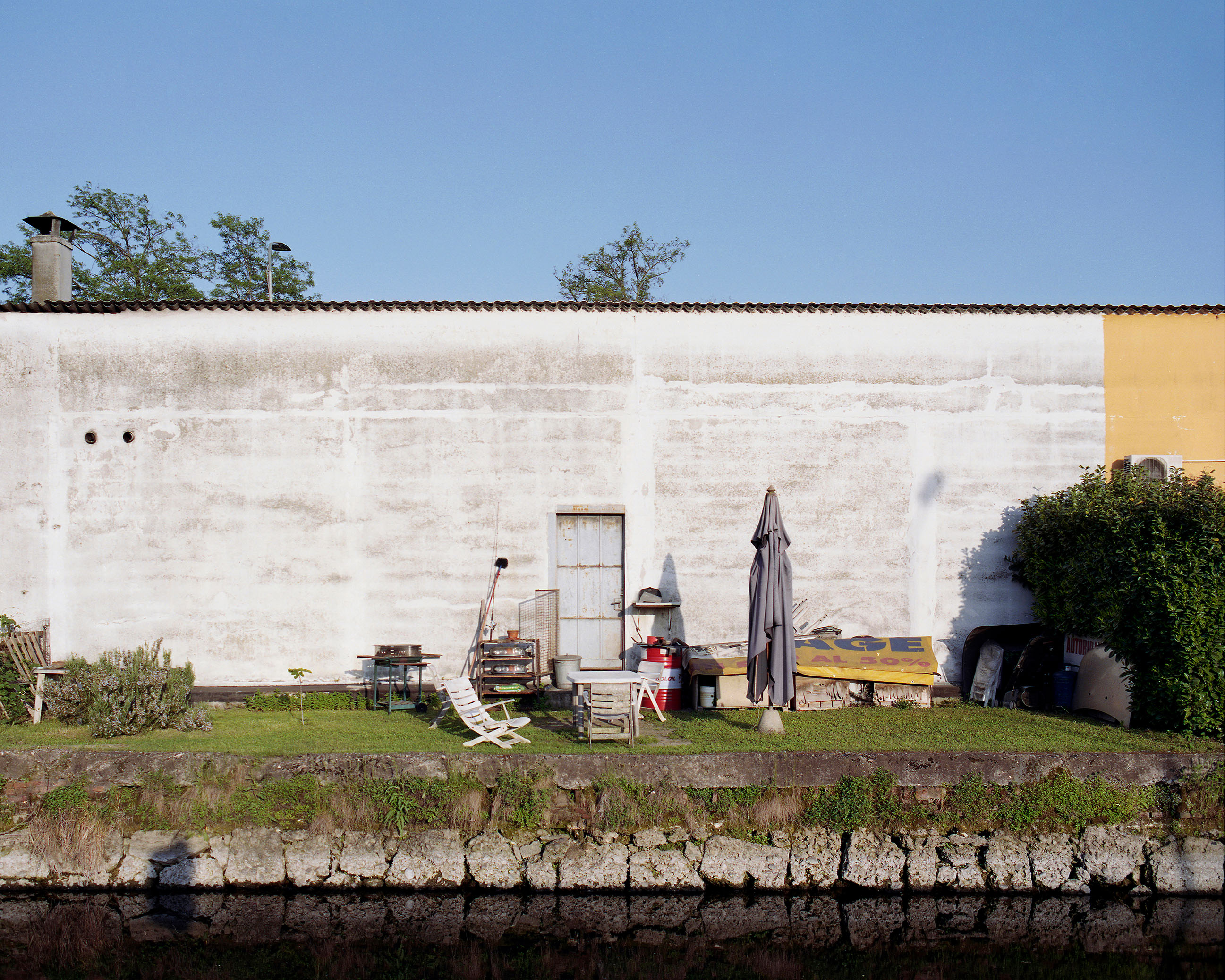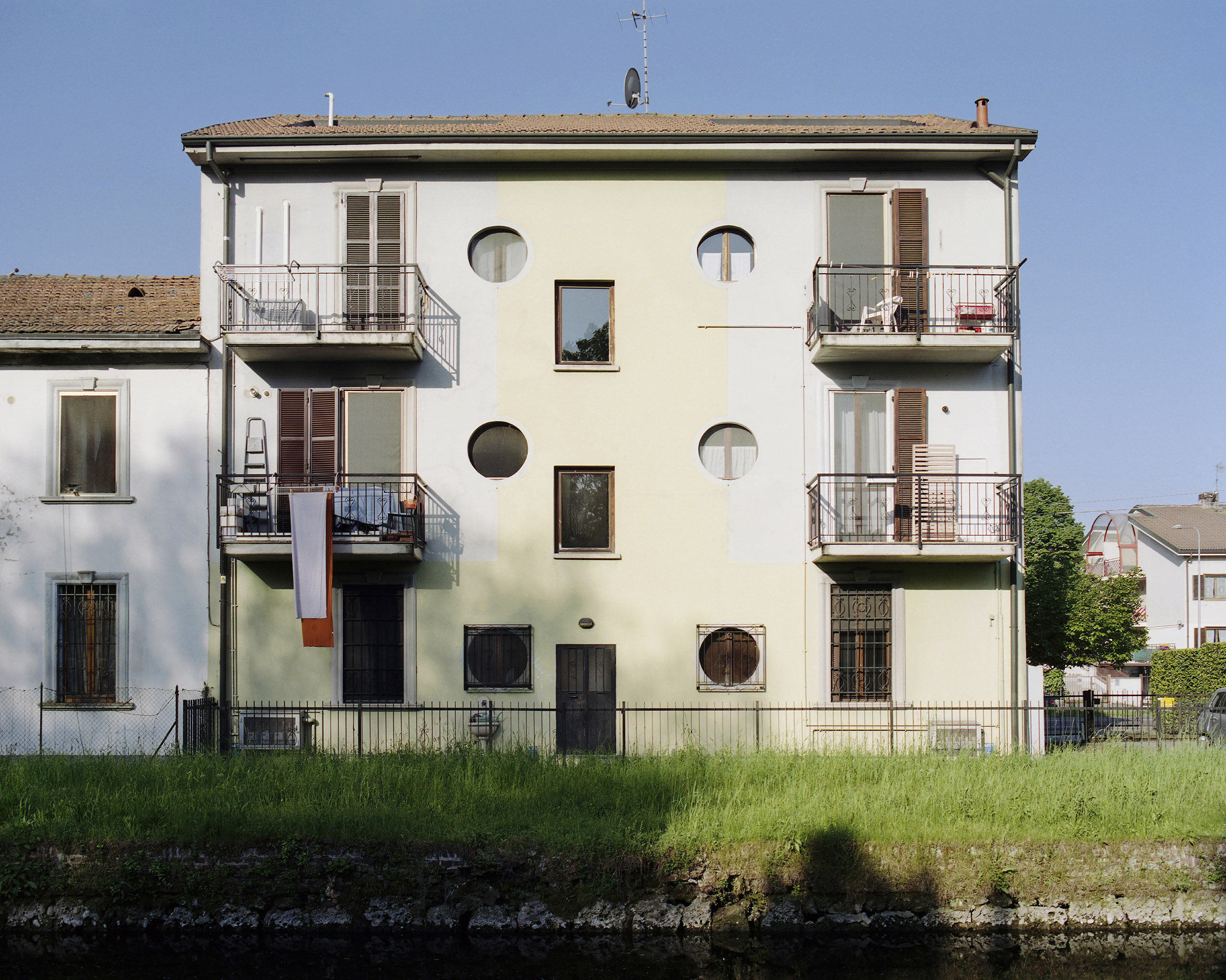Di fronte al Naviglio - PERIMETRO
The project “Di Fronte al Naviglio” took shape in the spring of last year, during one of my regular bike rides. Over the years, I’ve ridden the cycle path along the Naviglio Pavese countless times—a route I know almost by heart.
The first stretch unfolds on the outskirts of the city, passing through neighborhoods built in the 1960s and '70s, where apartment blocks line up in a steady rhythm. A bit further on, the scenery shifts again, giving way to a sprawl of commercial buildings, warehouses, and signs. The noise of the city accompanies the early part of the ride, but gradually it fades, until only silence remains—and the presence of the landscape.
And yet, one is never truly alone. On the opposite bank of the Naviglio lies a silent, unchanging micro-world, present in every season. Each building facing the canal tells its own quiet story, with its own distinct character: public housing, workshops, old factories, modest houses, rusted garages.
These places are full of details—tiny, eloquent objects that seem to demand your attention. So I stop, drawn in by this suspended reality, by this sense of time standing still. It’s a kind of periphery that, to someone arriving from the big city, appears almost frozen, like a stage set waiting for something to happen.
The first stretch unfolds on the outskirts of the city, passing through neighborhoods built in the 1960s and '70s, where apartment blocks line up in a steady rhythm. A bit further on, the scenery shifts again, giving way to a sprawl of commercial buildings, warehouses, and signs. The noise of the city accompanies the early part of the ride, but gradually it fades, until only silence remains—and the presence of the landscape.
And yet, one is never truly alone. On the opposite bank of the Naviglio lies a silent, unchanging micro-world, present in every season. Each building facing the canal tells its own quiet story, with its own distinct character: public housing, workshops, old factories, modest houses, rusted garages.
These places are full of details—tiny, eloquent objects that seem to demand your attention. So I stop, drawn in by this suspended reality, by this sense of time standing still. It’s a kind of periphery that, to someone arriving from the big city, appears almost frozen, like a stage set waiting for something to happen.
Il progetto “Di Fronte al Naviglio” prende forma nella primavera dello scorso anno, durante una delle mie abituali uscite in bicicletta. Nel corso degli anni ho percorso innumerevoli volte la ciclabile che costeggia il Naviglio Pavese, un tragitto che conosco quasi a memoria.
La prima parte del percorso si snoda ai margini del centro urbano: si attraversano quartieri costruiti tra gli anni Sessanta e Settanta, dove i palazzi si susseguono uno dopo l’altro in un’alternanza regolare. Poco dopo, il paesaggio cambia nuovamente, aprendo la strada a una distesa di edifici commerciali, capannoni, insegne. Il rumore del traffico e della città accompagna i primi chilometri, ma pian piano si affievolisce, fino a dissolversi del tutto. Resta solo il silenzio, e la compagnia del paesaggio.
Eppure, non si è mai davvero soli. Sul lato opposto del Naviglio si dispiega un micro-mondo silenzioso, immutabile, presente in ogni stagione. Ogni edificio che si affaccia sull’acqua racconta una piccola storia, possiede una sua identità distinta: palazzi popolari, officine, vecchie industrie, case basse, garage arrugginiti.
Sono luoghi pieni di dettagli, costellati da oggetti minuscoli eppure eloquenti, che sembrano chiedere di essere osservati. E così mi fermo, attratto da quella realtà sospesa, da quel tempo che sembra essersi fermato. È una periferia che, agli occhi di chi arriva dalla grande città, appare quasi immobile, come un fondale teatrale in attesa che qualcosa accada.
La prima parte del percorso si snoda ai margini del centro urbano: si attraversano quartieri costruiti tra gli anni Sessanta e Settanta, dove i palazzi si susseguono uno dopo l’altro in un’alternanza regolare. Poco dopo, il paesaggio cambia nuovamente, aprendo la strada a una distesa di edifici commerciali, capannoni, insegne. Il rumore del traffico e della città accompagna i primi chilometri, ma pian piano si affievolisce, fino a dissolversi del tutto. Resta solo il silenzio, e la compagnia del paesaggio.
Eppure, non si è mai davvero soli. Sul lato opposto del Naviglio si dispiega un micro-mondo silenzioso, immutabile, presente in ogni stagione. Ogni edificio che si affaccia sull’acqua racconta una piccola storia, possiede una sua identità distinta: palazzi popolari, officine, vecchie industrie, case basse, garage arrugginiti.
Sono luoghi pieni di dettagli, costellati da oggetti minuscoli eppure eloquenti, che sembrano chiedere di essere osservati. E così mi fermo, attratto da quella realtà sospesa, da quel tempo che sembra essersi fermato. È una periferia che, agli occhi di chi arriva dalla grande città, appare quasi immobile, come un fondale teatrale in attesa che qualcosa accada.











